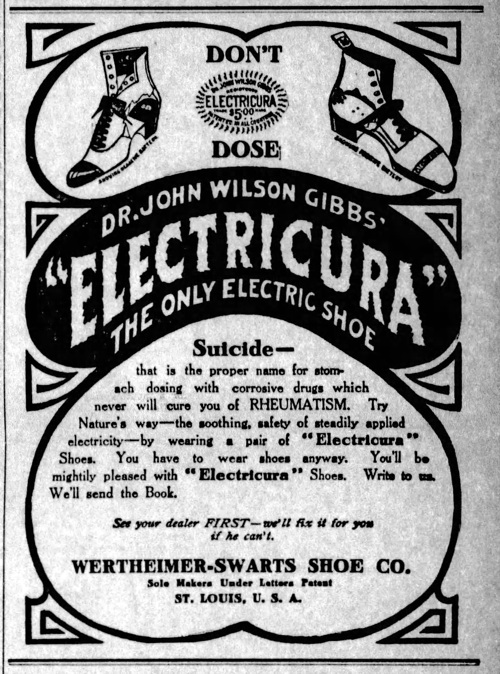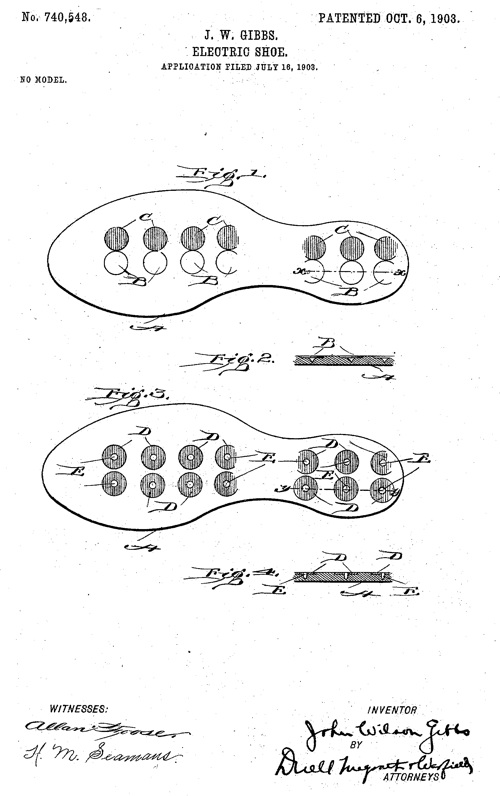Electricura Shoes
John Wilson Gibbs claimed that his patented "electric shoe" would cure rheumatism.

How the shoes generated electricity is explained in his 1903 patent (No. 740,548). They contained zinc and copper nails. The two metals, when combined with sweaty feet, would form a galvanic cell, producing a mild electric current.
What he doesn't mention is that the metals would quickly corrode, at which point the electricity would stop. Not that such a tiny amount of electricity would have had any therapeutic effect anyway.
Of course, this was back in the era when adding the word "electric" to any product was a sure way to give it more consumer appeal. A long time ago I had a brief article published in Smithsonian magazine in which I gave some examples of this phenomenon.


Kansas City Star - July 23, 1907
How the shoes generated electricity is explained in his 1903 patent (No. 740,548). They contained zinc and copper nails. The two metals, when combined with sweaty feet, would form a galvanic cell, producing a mild electric current.
This invention relates to an electric shoe; and its object is to provide, in connection with the sole of a shoe or other article of footwear, a means permanently attached thereto, such that an electric current will be generated under the influence of the foot of the wearer. . .
The sole of the shoe is shown at A, and in the upper surface thereof there are driven or otherwise inset a series of nails or studs B, with each of which there is associated a similar nail or stud C. The studs of the series B are preferably of zinc and those of the series C preferably of copper, thereby providing pairs of elements of dissimilar metals or opposite in sign such that when contacted with by the foot of the wearer from the influence of the warmth or moisture of the person or for other reasons an electric current will be generated, passing from one element to the other through the body of the wearer. The medical and therapeutic effects of such a current are well known, and I claim herein only the specific construction of the means for obtaining such a current.
The sole of the shoe is shown at A, and in the upper surface thereof there are driven or otherwise inset a series of nails or studs B, with each of which there is associated a similar nail or stud C. The studs of the series B are preferably of zinc and those of the series C preferably of copper, thereby providing pairs of elements of dissimilar metals or opposite in sign such that when contacted with by the foot of the wearer from the influence of the warmth or moisture of the person or for other reasons an electric current will be generated, passing from one element to the other through the body of the wearer. The medical and therapeutic effects of such a current are well known, and I claim herein only the specific construction of the means for obtaining such a current.
What he doesn't mention is that the metals would quickly corrode, at which point the electricity would stop. Not that such a tiny amount of electricity would have had any therapeutic effect anyway.
Of course, this was back in the era when adding the word "electric" to any product was a sure way to give it more consumer appeal. A long time ago I had a brief article published in Smithsonian magazine in which I gave some examples of this phenomenon.

Comments
I wonder if there is a pair of these shoes in a museum anywhere.
It is really too bad that the museum of questionable medical devices is defunct. It was a real hoot. That collection was donated to a university, which has a few items on display. Ahh, fond memories of an entertaining museum...
It is really too bad that the museum of questionable medical devices is defunct. It was a real hoot. That collection was donated to a university, which has a few items on display. Ahh, fond memories of an entertaining museum...
Posted by Patrick on 03/11/24 at 08:20 AM
Yes, the zinc is the sacrificial anode, but I think it (and the copper) will outlast your skin. No socks allowed, ya know.
Posted by Virtual in Carnate on 03/11/24 at 06:08 PM
"Nature's way"...
@Virtual: your skin will regenerate. The anode will not.
@Virtual: your skin will regenerate. The anode will not.
Posted by Richard Bos on 03/17/24 at 05:21 AM
Commenting is not available in this channel entry.

Category: Patents | Shoes | 1900s